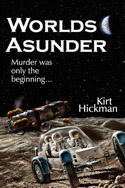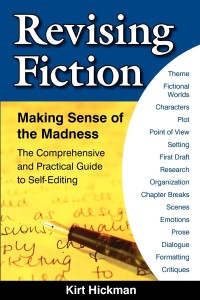by Kirt Hickman
For many writers, the challenge of story lies in how to plot, rather than plod, through the long, languid, middle of the novel. The key to holding your reader’s attention lies in the art of maintaining suspense. This article presents a list of elements that will increase the suspense in your story. Build as many into your plot as it can accommodate.
1. Make at least one character especially violent or adversarial. This character is a wild card. He should have the ability and inclination to severely and unexpectedly hurt your hero (or at least hurt your hero’s chances of achieving her goal).
2. Spring surprises. Keep the reader guessing. Provide many obstacles that come at your hero when she least expects them and when your reader least expects them. Provide at least one surprise turning point in each chapter. These surprises must not be contrived events, however. They must all stem from the characters, their goals, and their motivations.
3. Mislead your reader. If you mislead your reader, the surprises will have more impact. Nevertheless, you must play fair. Leave clues that are consistent with who your characters are—even if the characters are different from how your reader believes them to be.
4. Do your worst. In every scene, ask yourself: What is the worst thing that could happen to the hero? Then make it happen.
5. Take away that which is most important to your hero. What does your hero care about more than anything else? Take it away, or better yet, destroy it. At the very least, put it at risk.
6. Haunt your hero with memories of a past failure. Relate the failure to the events in the book. Put your hero in the same situation she was in when she experienced her failure. Use her memories of that failure to undermine her confidence and make her challenges more difficult and more personal.
7. Turn the environment loose upon your characters. In my science fiction novel, Worlds Asunder, the vacuum of space lurks beyond the walls of the buildings, vehicles, and pressure suits that keep my characters alive. I frequently turn it loose inside.
For the purpose of building suspense, “environment” doesn’t have to mean “natural phenomena.” It can refer to any element of the character’s surroundings that is beyond the control of the main characters, including sociological, political, or economic circumstances and events. To keep an environmental event from seeming contrived, establish early that such an event is possible.
8. Employ phobias. What is your hero afraid of? Make him confront the source of his fear. If you choose something the reader also fears, it will heighten his emotional response.
9. Never make anything easy. Turn all your minor challenges into major ordeals. Make even simple tasks difficult if circumstances can justify your doing so.
10. Show that the danger is real. Hurt your hero, kill a good guy, or both. If you kill someone your hero cares about, it will raise the personal stakes and inject a strong emotional element into your plot. At one point in Worlds Asunder, my hero is hospitalized for his wounds following a battle for his life. In addition, several good guys die, including one of my hero’s closest relatives. This shows that the threat to him is very real.
11. Impose a deadline. This is the ticking clock. It need not be a clock the hero can see, or one with a specified time to zero, but one way or another you must create a sense of urgency.
In Worlds Asunder, the political events surrounding my hero’s investigation escalate toward war. If he can solve the case in time, his findings might defuse the building crisis. He doesn’t know how much time he has, but he and the reader can see the escalation. In alternating scenes, the hero takes a step toward solving the case, and then political events expand. This creates an unseen clock. My hero and the reader are never quite sure it hasn’t already reached zero, the point beyond which no one can stop the war.
12. Prevent your hero from running away. You don’t need to impose a physical barrier, but make your hero’s need to stay in the conflict stronger than his desire to escape it. The same must be true for your villain. In Worlds Asunder, my hero wants to retire and go home to his family—that would be his escape—but averting war is much more important. He won’t quit, even when the stakes rise and he must risk losing his own daughter.
Use these techniques in combination. Don’t restrict yourself to one suspense builder per scene. Stack these elements one upon another, particularly in key scenes. This will compel your reader to keep turning the pages.
 Kirt Hickman is a technical writer turned fiction author. His books include three sci-fi thriller novels Worlds Asunder (2008), Venus Rain (2010) and Mercury Sun (2014), the high fantasy novel Fabler’s Legend (2011), and the writers’ how-to Revising Fiction: Making Sense of the Madness (2009).
Kirt Hickman is a technical writer turned fiction author. His books include three sci-fi thriller novels Worlds Asunder (2008), Venus Rain (2010) and Mercury Sun (2014), the high fantasy novel Fabler’s Legend (2011), and the writers’ how-to Revising Fiction: Making Sense of the Madness (2009).
This article was originally published in the December 2009 issue of SouthWest Sage and is reprinted here by permission of the author.



Leave a Reply